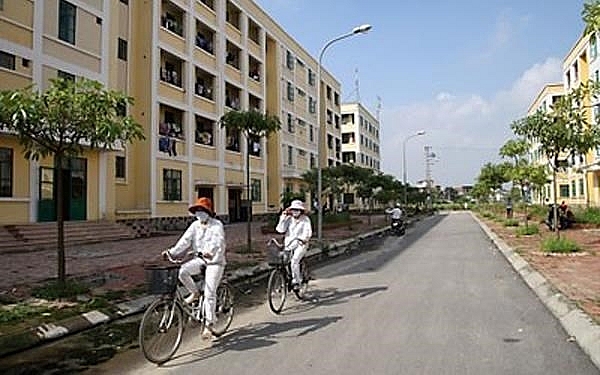Migrant workers in IZs face difficulties in finding accommodation
 |
| Accommodation for low-income workers in industrial and economic zones (IZs and EZs) has become more scarce in the face of increasing demand. (Photo: vov.vn) |
Many experts suggested that the Government needed to give priority to both procedures and capital to develop low-cost housing, according to Kinh Te & Do Thi (Economy & City) Newspaper.
Nguyen Hong Co, from northern Hai Duong province, said “I had to rent a house when my wife and I were working in Sai Dong IZ in Hanoi’s Long Bien district.”
“But as we struggled to find accommodation and schools for our child, my wife had to take the child and move back home to the countryside,” Co said.
“I quit the job in the IZ and became a xe om – motorbike taxi driver,” the man said.
This was due to the expensive rent for a small room which could not even fit my family, he said.
Co’s case was not rare.
It is becoming more common for workers to leave rural areas and search for work in the big cities.
According to statistics by the Ministry of Planning and Investment, Vietnam will have 7.2 million employees working in IZs and EZs nationwide next year.
There will be 4.2 million workers needing accommodation, equal to 33.6 million sq.m of housing.
Currently, about 20 percent of workers working in the IZs have found stable accommodation.
Most migrant workers had to rent small and shabby rooms.
On average, each worker had 2 or 3 sq.m of accommodation.
The makeshift and unhygienic accommodation was harmful to health and threatened security and social order in the IZs, said the paper.
With low income of 3-4 million VND (130-170 USD) per month, they could not afford better places.
“I was unable to sleep during the summer, even at night,” Huong, a worker from Diem Thuy IZ in Thai Nguyen province told Thai Nguyen Newspaper.
“We could not afford air-conditioning,” she said.
To save money, the migrant workers often shared rooms with their colleagues.
“I share a room with two others to save money,” said Trieu Van Tuan, a worker in Song Cong IZ 1.
“The small room was really uncomfortable for three of us,” he said.
For married couples, they did not dare bring their children along.
Government support needed
The Government, in recent years, has spent money to carry out a national target programme on housing for low-income persons and workers in IZs and EZs.
Under the programme, next year there must be about 12 million sq.m of accommodation for workers nationwide.
But so far, only 4.1 million sq.m of housing, equal to 33 percent of the target, has been completed.
According to Tran Huy Anh, member of the Hanoi Architects’ Association, real estate businesses were not keen on housing projects for low-income buyers although the government had offered several preferential policies.
“Low profit and long capital return were major reasons hindering real estate enterprises,” Anh said.
“This leads to a scarcity of accommodation for low-income people and especially poor migrant workers,” the architect said.
Recently, the Ministry of Finance has issued a circular offering preferential policies to housing projects for workers of IZs and EZs.
Accordingly, businesses who carry out the projects would receive income tax deductions based on expenses in construction, operation and lease of apartment buildings and infrastructure work for workers of IZs and EZs.
President of the Vietnam Real Estate Association Nguyen Tran Nam said that in the past, the Government offered a credit package of 30 trillion VND (1.3 billion USD) for housing projects for low income people.
The credit package was useful to attract financial sources at the time, Nam said.
But after the credit package was terminated, smaller packages didn’t interest investors any more, Nam said.
Meanwhile, Nguyen Manh Ha, Chairman of the Vietnam Real Estate Brokers’ Associations, said that housing development for low-income people was far below expectations.
This was due to a lack of land fund, Ha said.
“Although many IZs have been completed, there was no land for building accommodation for workers,” he said
Construction of for-lease accommodation needs long-term investment while bank interest rates were high.
That’s why the housing projects did not attract investors, he added.
The Government should consider a reasonable interest rates of 3 percent per year to both investors and house buyers so as to attract financial sources, Nam suggested.
“Moreover, administrative procedures related to project evaluations, planning approval, and investment licensing should be further simplified,” he said.
What the stars mean:
★ Poor ★ ★ Promising ★★★ Good ★★★★ Very good ★★★★★ Exceptional
Related Contents
Latest News
More News
- Women lead Vietnam’s shift to climate-resilient agriculture (December 03, 2025 | 19:10)
- Experts highlight unpaid care work as key barrier to gender equality (December 03, 2025 | 15:15)
- Opportunities and inequalities for women workers in Vietnam's garment industry (December 03, 2025 | 09:00)
- Vietjet flights carry love to devastated central region (November 28, 2025 | 11:35)
- New initiative to boost the fight against domestic violence (November 26, 2025 | 10:00)
- South Korea funds IOM relief for Vietnam’s typhoon-affected communities (November 24, 2025 | 15:33)
- AI and human-centred values set to shape the future of HR in Vietnam (November 21, 2025 | 18:04)
- Kimberly-Clark and UNICEF strengthen child and maternal healthcare (November 17, 2025 | 18:08)
- Nestlé expands support for education and active lifestyles in Vietnam (November 17, 2025 | 17:52)
- Swing for the Kids Foundation supports school upgrades in Nghe An’s Do Luong district (November 16, 2025 | 10:00)

 Tag:
Tag:






















 Mobile Version
Mobile Version